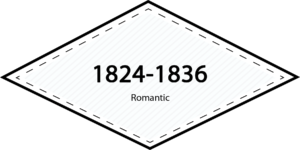
“Age of Romance”
In a world of peace & prosperity; return to a chivalrous & innocent time contrived by strong corsets & legal reform
—— THE ERA IN BRIEF ——
Just when women reached for independence, the genteel “Ideal Woman” appeared to pull her hand back. The Romantic woman was demure, feminine, & lived to serve her man. Fashions of the era, modeled after swooning literary characters, enhanced the image. Meanwhile back in reality, countries were changing hands, legal reforms were improving women’s situation, & people were taking the train into town to the department store to shop.
 —— PORTRAITS OF REAL WOMEN OF THE ERA ——
—— PORTRAITS OF REAL WOMEN OF THE ERA ——
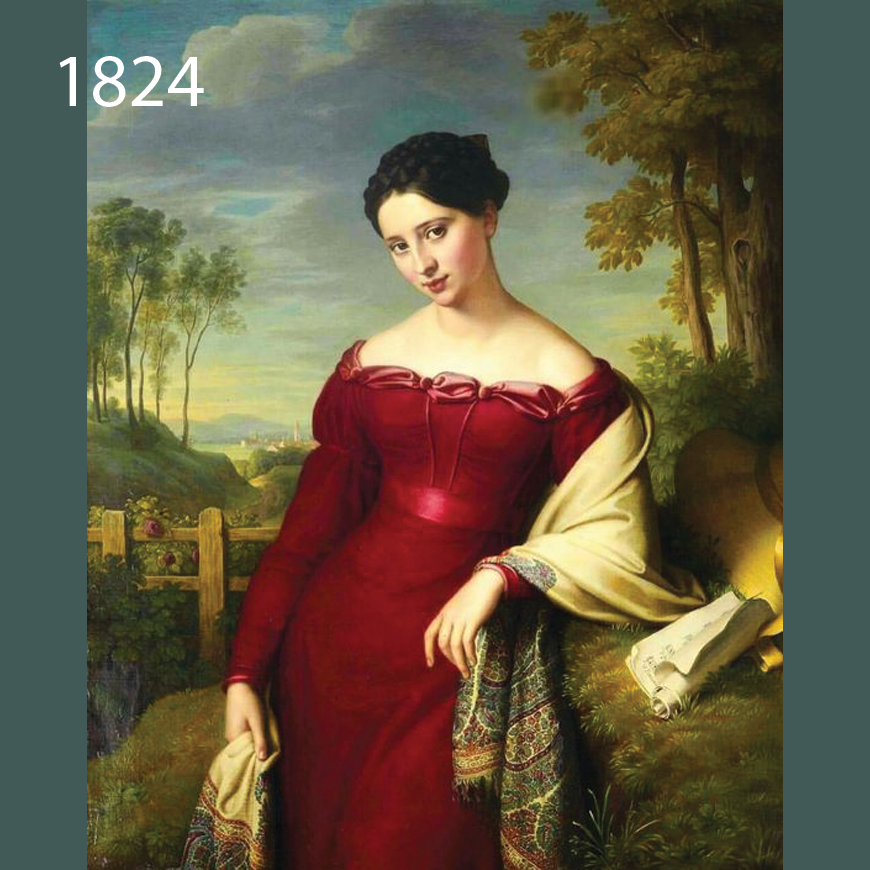
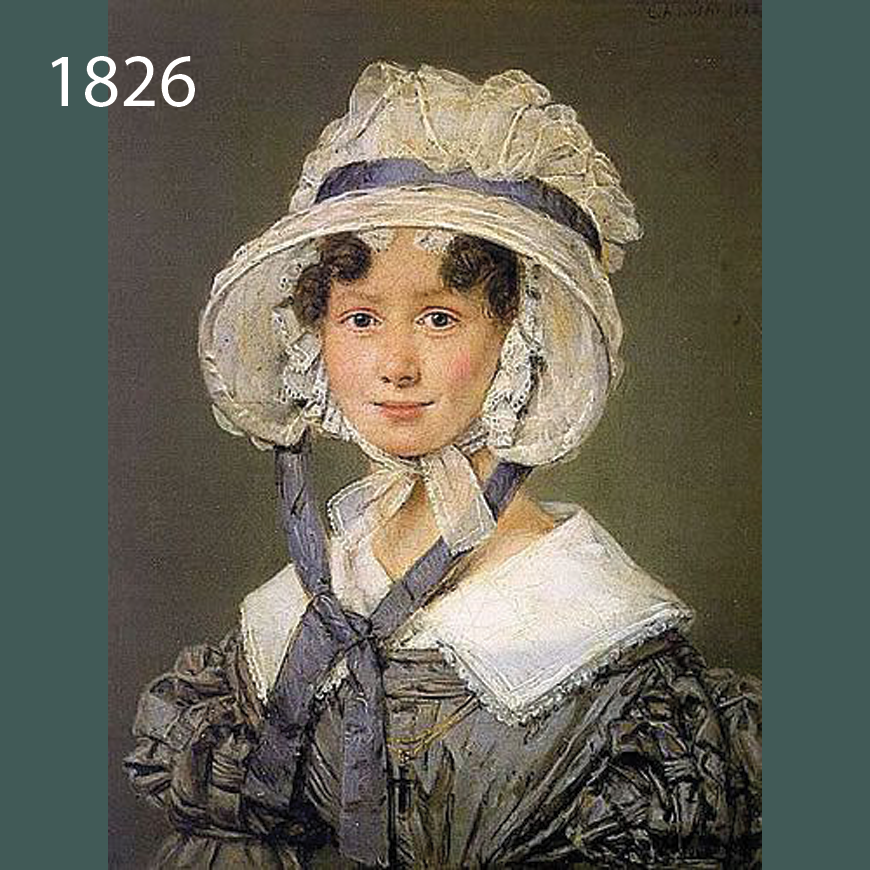
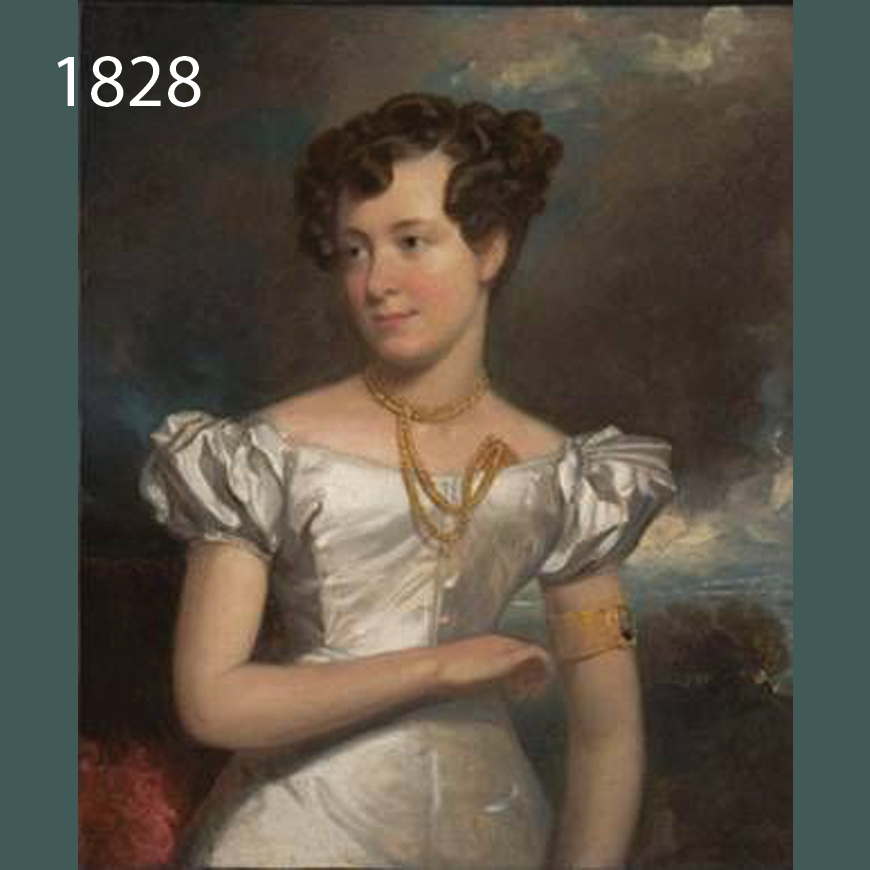
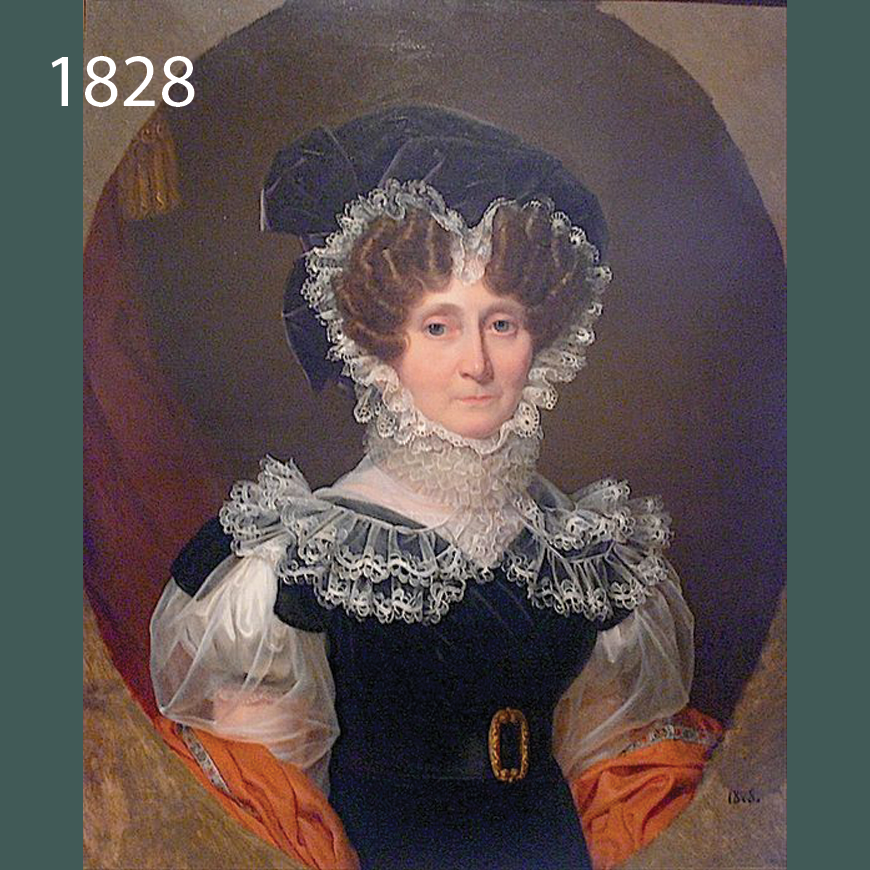
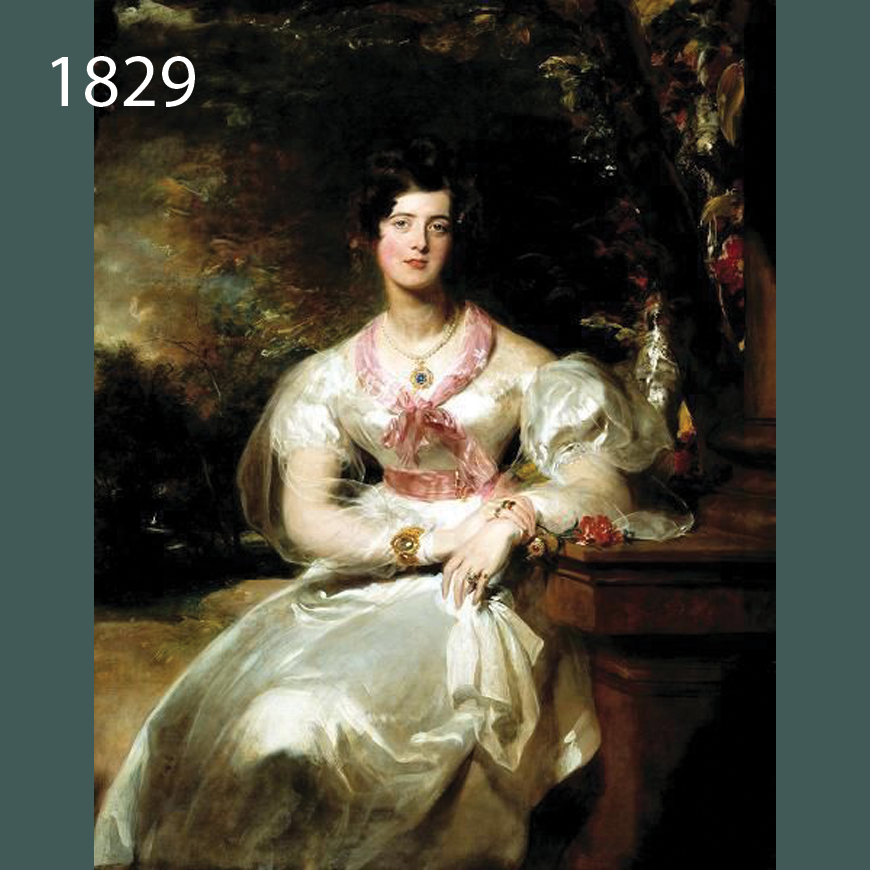
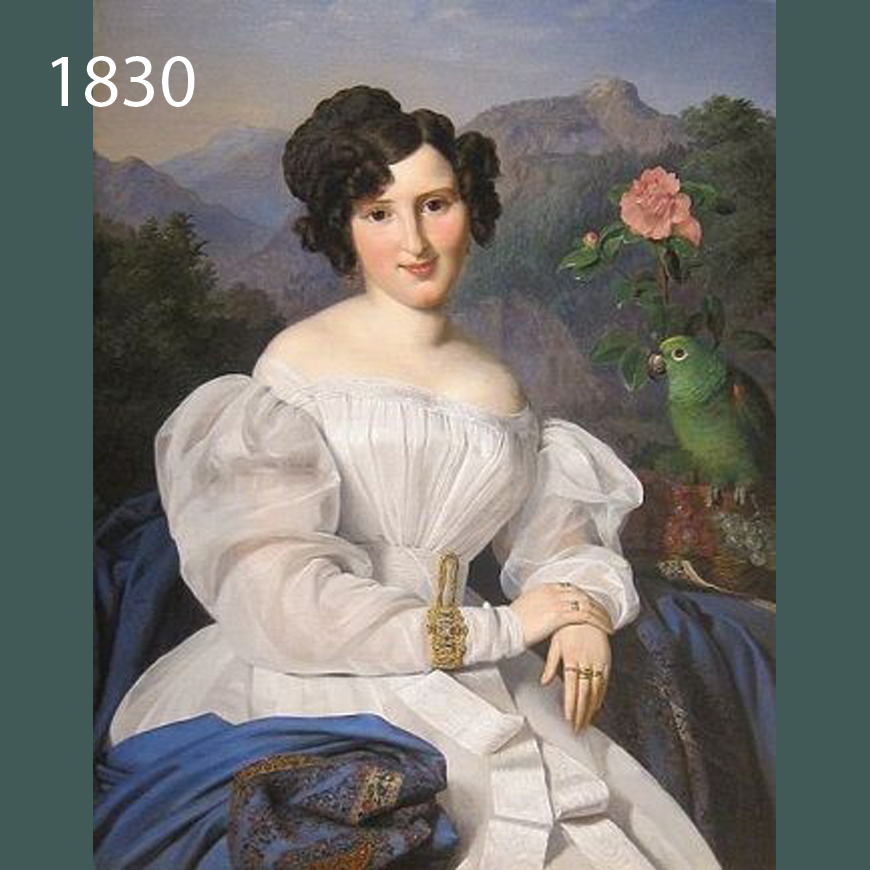
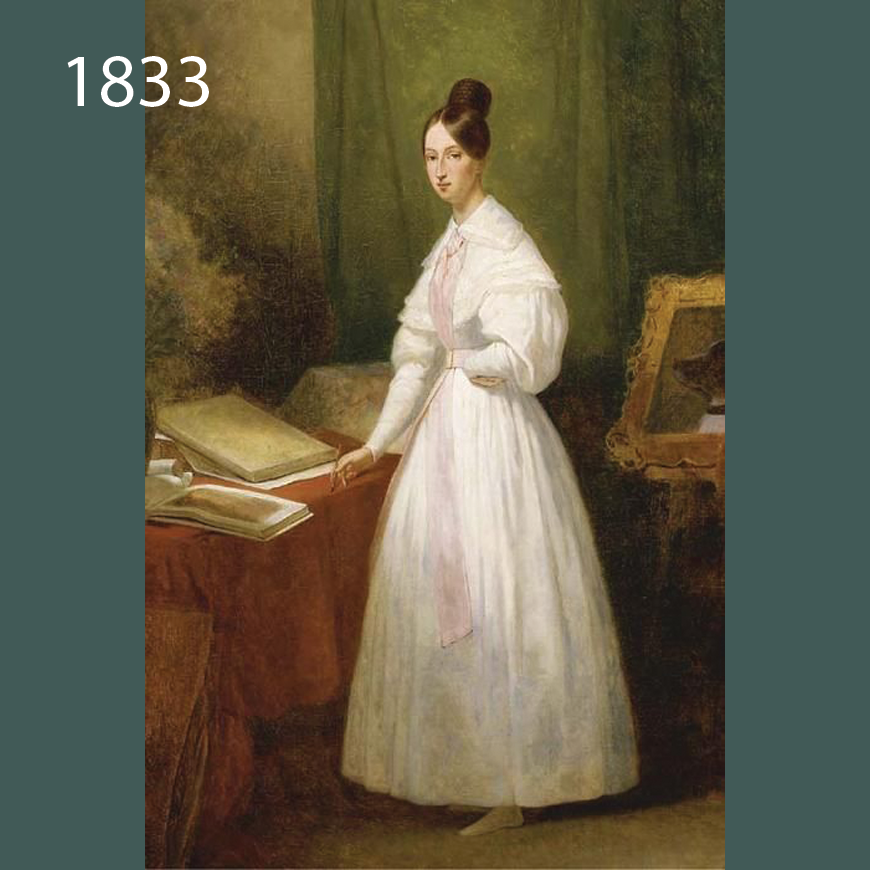
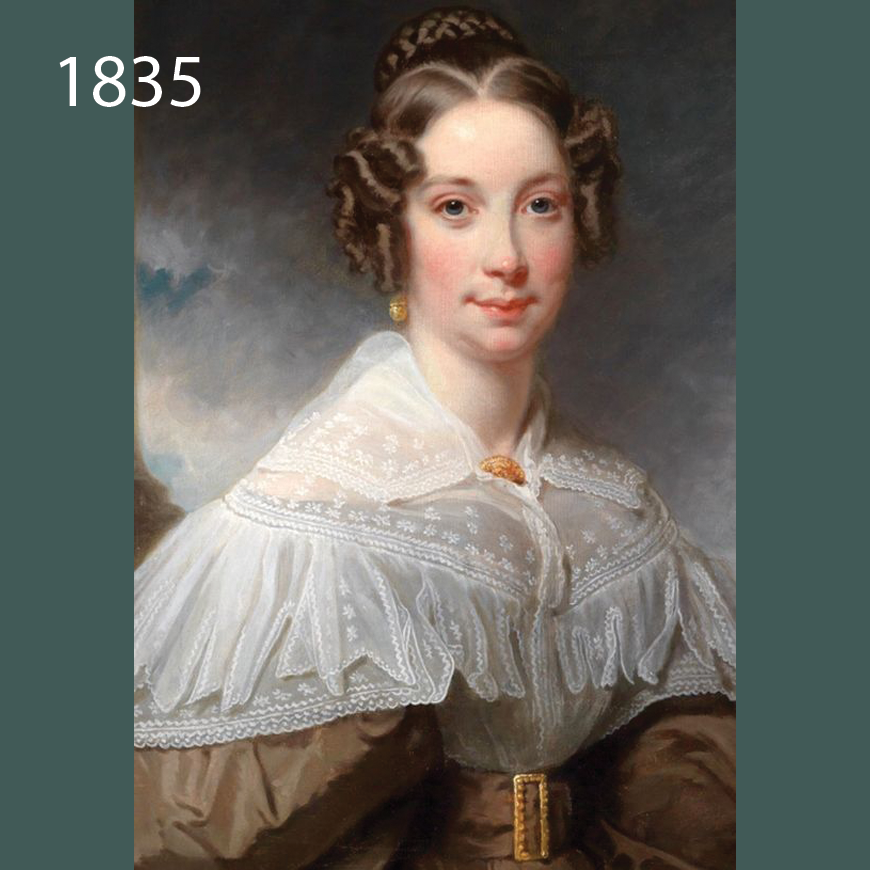

—— WORLD SITUATION ——
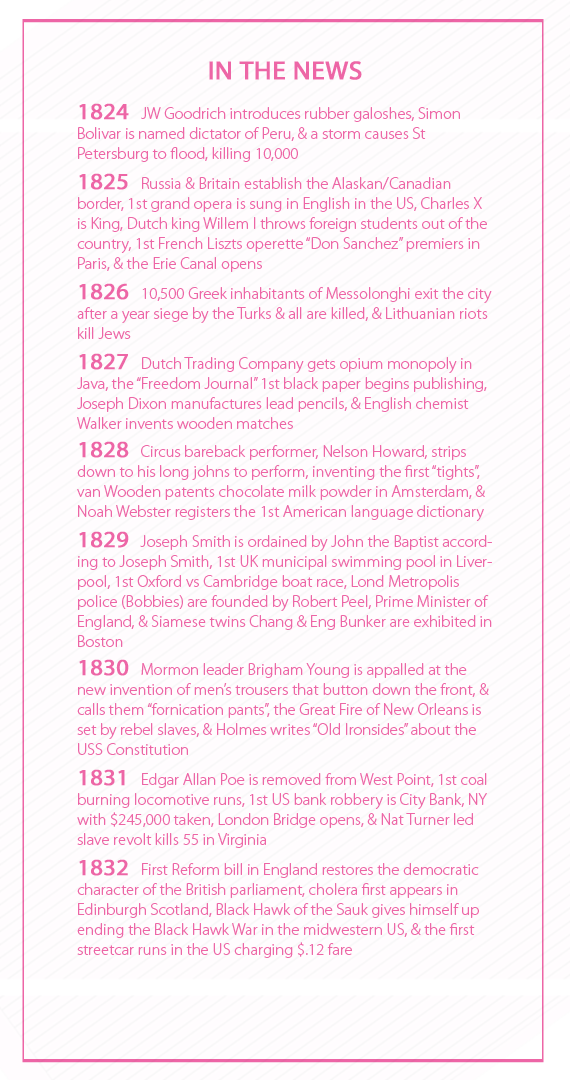
NEW BOUNDARIES
- The end of the 1820’s saw the rise of Romanticism
- The world was relatively peaceful & prosperous, at least compared to the prior 50 years of war & conquest on every continent
- Women at this time had the most freedom they had yet in history
- The era included freedom in manners & physical movement (e.g. travel) for all classes & genders
- Women were establishing new roles
- The 19th century was a time when hard work & not just your birthright could have you go from rags to riches or from a log cabin to the White House
- Legal reforms, particularly in England & America regarding slaves, women, & criminals made a century full of heroines from Josephine to Queen Victoria to the Gibson Girl of the 1890’s
- America was tracking election results & had developed bureaus for everything including Indian Affairs
- Charles X was the last Bourbon king to rule France
- Wealth was the common language of the century
- Major countries that had been in conflict finally established peace treaties & agreed upon border lines
- Russia set permanent boundaries in North America
- Brazil, Mexico, Bolivia, & Uruguay all become independent after years of occupation
- Liberia was established by freed American slaves as an independent country on the African continent
- Siam & Britain were at peace at last, although Britain declared war on Burma
- Britain & the Netherlands settled into a trade agreement after years of conflict
- Tension in America between Native Americans was easing as Indians were settled on reservations
- The removal of Cherokee from Georgia was of terrible consequence. The “Trail of Tears” ended Native American suppression as most tribes were moved west of the Mississippi
- The princess of Java declared war on all non-Islams, & through the era would attack peaceful settlements of all nationalities
- The Greek War of Independence continued conflict with the Turks
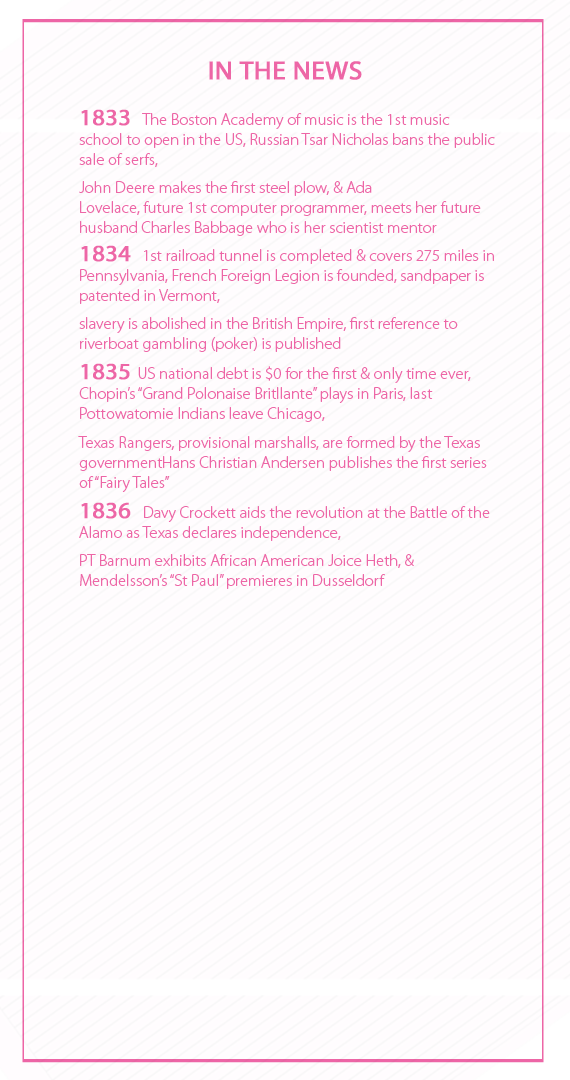
INNOVATION
- It was a time of yet more innovation. The removable collar was invented by a woman in New York
- Inventions included the washing machine, tin can, first suspension bridge, portland cement, canals, friction striking match, & the combustible engine “Gas or Vapour”
- Transportation boomed: canals were completed & the USS Vincennes the first warship to circumnavigate the globe
- The first complete railroads for steam engine were finished in Stockton-Darlington, England, & Massachusetts
- Organizations such as the Altheanaeum Club in England, the New Harmony “Utopian” settlement by a Scottish factory owner in Indiana, & the colony at Salt Lake City, Utah by Jedediah Smith & the Mormons, brought new concepts & philosophies of living
- Many colleges & universities were established in the US & Britain
- Lord & Taylor opened the first American department store in New York in 1826, & New York City opened the “5th Avenue” shopping district
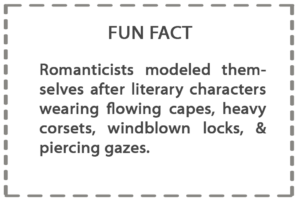

—— INTERESTING FACTS ——
THE LIBERATED WOMAN… EXCEPT
- Society as a whole was less restrictive in the early 1820s than it would be for the next hundred years
- Women’s freedoms came from:
- Technology that reduced their drudgery
- Communication that allowed them to understand (if not yet participate) in world & local politics
- The ability to participate in invention (& particularly science & manufacturing)
- Freedom to express their thoughts
- Economic stability – particularly of a strong middle class in America – & a type of affluence that was not necessarily comfortable, but was not limiting
- The concept was being accepted that a woman could rise financially, socially, & spiritually through her own actions & efforts
- Into this freedom, in the mid-1820’s entered the sobering concept of “Ideal Womanhood”
TIED DOWN BY ROMANCE
- The Romantic era represented the “Ideal of Womanhood” which would be learned & expressed through fashion
- The “Ideal of Womanhood” dictated that a woman’s objective in life was to be morally pure, stay close to home, & to shape the world through her calming influence on her man
- Romanticism appealed to people who were yearning for simpler, nobler times when troubadours sang of chivalry & hopeless love, as an escape from the real world into a world of mystery & intrigue
- Men were to protect their woman from a world thought to have become harsh & dangerous due to the advance of technology
- Part of the schooling of women to their new role came through trends in fashion
- Romanticists modeled themselves after literary characters, wearing velvet capes, heavy corseting, windblown locks, & piercing gazes
- Romanticism would challenge the bourgeois values, social conformity, & class structure
- This “Age of the Genteel” began in this era to teach a distinction of class through thought & behavior, most likely to regain lost social structure
- It is thought the subsequent Victorian & Edwardian eras might have been a “pendulum swing” in response to this time of freedom, back to a time of rules & restrictions
- It is also thought that forcing women to wear petticoats again, & to exercise “prudence” in an otherwise free & exciting time for them kept their newfound independence in check
WHILE THE INDUSTRIAL REVOLUTION MARCHES ON
PHOTOS
- The final months of the 1830’s saw a revolutionary new technology: photography.
- Portraiture preserved for the first time images of the real behavior of human beings: what they were wearing & how they behaved in it
- From the furthest reaches of the American west to the fashion houses of Paris, people could see each other as they really were through photographs
FABRICS & DYES
-
- In America, there was a great variety of fabrics available for making clothes
- American fabrics were all “natural”: wool & linen being most common, with cotton & silk scarcer & more expensive as they had to be imported until US mills began producing finished cotton in the late 1820’s
- Hundreds of weaves & patterns were available worldwide
- There were many innovations in roller printing on textiles
- A rich selection of colors existed even before synthetic dyes would be developed in the late 1850’s
- Early colors were made from plants
- Leaves, stems & blossoms were used from trees & flowers of the woods & meadows
- Roots, barks, nut hulls, tree galls, berries, fruits, pits, skins, mosses, lichens, & fungi were used
- Non-plants, such as insects & shellfish were used to make dyes
- Many dye sources were imported from tropical areas, & were sold in general stores where they were widely available to both home & commercial dyers
- Professional dyers sometimes supplied services directly to home spinners & weavers
- Rich colors such as the Turkey red fabrics of the 1820s were still found, but delicate floral prints on light backgrounds were increasingly more popular
- More precise printing eliminated the need for dark outlines on printed designs, & new green dyes appeared in patterns of grasses, ferns, & unusual florals
- Combinations of florals & stripes were fashionable
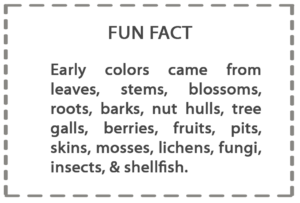

—— FASHION TRENDS ——
-
-
- While their mothers copied Greeks & Romans, the young women of the 1820’s looked to “Lady Guinevere”
- Lord Byron’s poetry wildly set the standard of good looks, lameness in men, & a flamboyant lifestyle that was the Romantic objective
- The ideal lady was fluttery & helpless, partly because she was again swathed in layers of clothes & a tight corset that made it hard to breathe
- Fashion of this Romantic era put emphasis on the “aesthetic” experience, or the emotion
- Being “picturesque”, or creating an overall image that evoked strong emotions was the objective
- Romantics were all about attitude; swooping about in capes with 2 day growths of beards, fine velvet jackets, & “Bohemian sensitivities”
- Gone was the freedom of the muslin dress; replaced by full skirted gowns with full leg o-mutton sleeves, & teeny tiny corseted waists
- Having started in about 1815, women were fully embracing the new look by the mid 1820’s
- They were probably getting too old to show so much skin, or tired of being cold all the time with the “little white gowns” of Regency, & glad to cover themselves up with the Romantic robes
- While reluctant to let go of all that classical charm of the past “Renaissance” era, the Romantic fad had led them back to works of art & literature about ancient societies
- Although they bathed more than the previous generation, they shunned cosmetics in favor of the delicate pallor brought on by drafty castles of their dreams
- If their skin was healthy, women blanched it with lead or vinegar to look sickly
- Bella donna was a deadly poison women put into their eyes to make them “luminescent”
- Daily sips of arsenic helped keep their skin pale
- Fashion became a mixture of “innocence & artifice”; some real hair & some fake; some real shape & some made by the trick of the eye
- The focus was clearly on femininity
- The problem with Romanticism was that it was VERY expensive
- Long flowing capes & Bella donna were not easy to come by
- Despite availability of mass produced items, they were not what was used to achieve the fashion of the day
- Expensive fabrics being used to get the romantic effects, plus the extra cosmetics & accessories, made the style impossible to maintain for most
- It was also highly impractical to wear in the field or factory
- The fashion went counter to women’s actual new mobility & place in society
- Only the high classes, nobility, & wealthy could continue the trend, & so it did not last long
- Class separation via fashion returned at this time
-
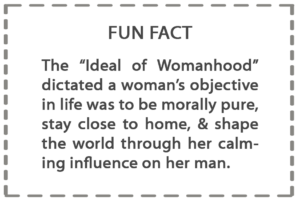

—— SPECIFIC FASHIONS ——
GOWNS
-
-
-
- The dress was no longer straight up & down.
- The fashionable feminine figure, with its sloping shoulders, rounded bust, narrow waist & full hips, was emphasized in various ways with the cut & trim of gowns
- Width at the shoulder & hip with a very tiny waist produced the 19th century’s first version of an hourglass silhouette
- From 1824 into the 1830’s, fashion was characterized by an emphasis on breadth, initially at the shoulder & later in the hips, in contrast to the narrower silhouettes that had predominated between 1800-1820
- Until about 1835, a wide belt with or without a buckle, like in the early 1820’s, was worn right under the bust to accentuate the small waist
- After 1825, the waist & midriff were unbelted, but cut close to the body. At this time, the bodice began to taper to a small point at the front waist
- Evening gowns had very wide necklines & short, puffed sleeves reaching to the elbow from a dropped shoulder
- Morning dresses generally had high necklines, & the visually broad shoulder width was created with tippets or wide collars that rested on the gigot sleeves
- Summer afternoon dresses might have wide, low necklines similar to evening gowns, but summer dresses had long sleeves
- In these, the skirt was pleated into the waistband of the bodice, & held out with starched petticoats of linen or cotton
- Chemisettes were popular. They were under-bodices of net or lace for low-necked gowns
-
-
BODICE & NECK
-
-
-
- The angular silhouette line which had been developing for some time reached its peak in the 1830’s, when the extension at the top of the dress & the extension at the base formed two triangles with the apexes meeting at the waist
- In the late 1830’s, when the sleeve collapsed, the silhouette became more rounded
- The center front of the bodice was sometimes slightly pointed, or worn with a Swiss belt which was pointed above & below the waist center front
- Bodices were cut as before, but were now always lined
- To create the wide shoulder silhouette, instead of being trimmed with applied decoration of the outer material, the outer material was draped over the bodice
- Pleated folds from the shoulders met at center front, or crossed over, or were draped to form a “Bertha” round top of the bodice
- A “Bertha” was when the drapery was cut on the cross grain, & then arranged on to the tight-fitting lining front & then back & seamed together on the shoulders & underarm
- This made the shoulder seams low at the back & the back side seams
- A modified “Betsy” or neck ruff was also popular
- “Mancherons” & wide collars gave further emphasis to shoulder width
-
-
SLEEVES
-
-
-
- At the start of the era, & keeping with the previous fashion style, sleeves were long & full; bound with cords spiraling down the arm
- The increase of sleeve size started with the puff sleeves at the shoulder becoming larger
- Then, in 1830, sleeves ballooned out from elbow to shoulder, & were fitted from elbow to wrist, replacing the demure cuffs of the 1810’s-20’s
- These were the elephant sleeves that would dominate this era, disappear quickly, & then return in 1895
- The giant sleeves were called “gigot” or “leg of mutton”. They had a triangular shape – very full at the top & fitting at the wrist
- By the end of the 1820’s the sleeve had become so extended it required extra support underneath. The enormous puffs & wings were padded, boned, or stiffened with down, stiffened interlining, & whalebones
- Shoulders visually disappeared until 1840, as huge, flat collars sloped from women’s necklines down to the fullest points of the giant sleeves
- For evening, the sleeves were wide & short & still often worn with a transparent over sleeve
- In 1836, having reached ultimate fullness, the sleeve style suddenly collapsed
-
-
SKIRTS
-
-
-
- By 1828 the skirt was shorter & at ankle length
- Around 1835, the fashionable skirt length for middle & upper class women’s clothes dropped from ankle to floor length
- The skirt expanded in circumference yet again since the last era
- The skirt was no longer gored, but cut from several widths of unshaped material
- Early in the era the fullness was arranged in pleats radiating from the center front & round the sides
- By the end of the 1830’s it was gathered all round
- Skirts were stiffened with buckram or horsehair to make them stand out, which was also used in sleeves & petticoats
-
-
UNDERGARMENTS
-
-
-
- Skirts were shaped by layers of starched petticoats that were stiffened with tucks & cording
- Petticoats worn were heavier, wider, & more numerous as time went on
- By 1825, the waist had reached the natural position
- A bustle (padded roll, not wire frame) or extra flounces held the fullness out to the back
- Undergarments of the era included down-filled sleeve plumpers, corset, chemise, & petticoat
- The chemise was knee-length with elbow length sleeves & made of linen
- Stays were now called corsets (after the French “corps” meaning body)
- A main distinction between stays & corsets was the invention of metal grommets & busks, which allowed extremely tight lacing
- Corsets had a center front busk & bones for center back lacing
- Becoming figure controllers, corsets would actually shape the body, rather than create a visual silhouette as was done with softer stays of the past
- Corsets allowed the extremely tight lacing that created a tiny waist, which was a particular vanity at this time
- Corsets compressed the waist & ran over the hips
- The gores/gussets made the bosoms round
- The fashionable corset now had gores to individually cup the breasts, & the dress bodice was styled to emphasize this shape
- At this time when the bodice fit all the way down to the waist, more seams were added & more bones, with sometimes a basque for the hips instead of gussets
- This basque style lasted until the late 1880’s
-
-
OUTERWEAR
-
-
-
- Huge sleeves, being difficult to stuff into the narrow sleeves of a pelisse, demanded a new type of garment for warmth
- The pelisse with its narrow shoulders was no longer practical, but it continued as a “pelisse-dress” rather than as a coat
- Short capes with longer front ends, called pelerines, became quite popular
- Full-length mantles (coats) were worn until about 1836
- Voluminous mantles of velvet or satin, with fur trim or fur linings in cold climates, were worn with the evening gown
- A mantlet or shawl-mantlet was a shaped garment like a cross between a shawl & a mantle, with points hanging down in front
- Shawls were still worn, as were tippets, but muffs became smaller
- Shawls were worn with short-sleeved evening gowns early in the decade, but they were not suited to the later wide gigot sleeves of the mid-1830s
- The burnous was a three-quarter length mantle with a hood, named after the similar garment of Arabia
- The paletot was knee-length, with three cape-collars and slits for the arms
- The pardessus was half or three-quarter length coat with a defined waist & sleeves
-
-
ACTIVEWEAR
-
-
-
- Riding habits consisted of a high-necked, tight-waisted jacket with the fashionable dropped shoulder & huge gigot sleeves
- The jacket was worn over a tall-collared shirt or chemisette, with a long matching petticoat or skirt
- Tall top hats with veils were worn when riding
-
-
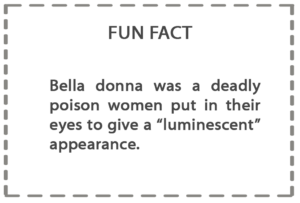
FABRIC & DECORATION
-
-
-
- Fabrics & colors were stronger now with purple, bright green, & blue being favorites
- Heavy fabrics such as plush, velvet, heavy woolens, brocade, & heavy silks were favorites year round throughout the era
- Cottons became firmer & there were many variations of cotton woven stripes & spot patterns
- Many of the woven striped or spotted fabrics were all white, but some spots & stripes were colored
- More silks, foulards, & satins, were being worn
- For evening crepe, net, or fine muslin was worn over a silk or satin slip (chemise)
- For evening, silks & gauzes were used alone or with the slip
- Embroidered white muslins were still worn, but now the embroidery was sometimes in colors, & the embroidery was heavier & coarser
- At the time of the large sleeve, draped bodice, & fuller skirt, there was less applied decoration & more use of patterned fabrics
- Favorite featured fabrics included printed cotton, chintz, challis (mixture of silk & wool), cashmere, & merino (light, short length wool)
- Trimmings & embroideries included beads & fringe
- Early in the era, dresses were still trimmed with applied decoration along the bottom of the skirt, but by the end decoration was placed on skirts at knee level
- Tucks, flounces, Van Dyked frills, trimmings bound with narrow piping, or trims embroidered in gold or silver, & ruching appeared round the bottom of the skirts
- On evening gowns, trim would be gauze caught with a narrow piping of satin or silk
-
-
JEWELRY
-
-
-
- In the early 1820’s, there was much less jewelry worn than in the past
- Jewelry consisted of brooches, bracelets, & crosses on chains around the neck
- Later, more jewelry was worn
- Later favorites were gold settings with semi-precious stones like turquoise, topaz, & amethyst
- There were brooches, earrings, & bracelets to match
- Bracelets were especially worn in the time around 1825
- The ferroniere of the previous era was especially popular. It was a jeweled headband worn across the forehead
-
-
HEADWEAR
-
-
-
- Early 1830’s hair was parted in the center & dressed in elaborate curls, loops, & knots extending out to both sides & up from the crown of the head
- This became the “spaniels ears” hairstyle in the late 1830’s-40’s
- The classical chignon of the 1810’s became the whimsical sausage curl of the 20’s & 30’s
- Bonnets with wide semicircular brims framed the face for street wear. These were heavily decorated with trim, ribbons, & feathers
- Married women wore a linen or cotton cap for daywear. It was trimmed with lace, ribbon, & frills, & tied under the chin. The cap was worn alone indoors & under the bonnet for street wear
- Unmarried women wore bonnets or hair ornaments over their natural hair, either in the chignon or “spaniels ears” styles
- Hair ornaments including combs, ribbons, flowers, & jewels were worn for evening
- Berets & turbans were popular for evening too
-
-
FOOTWEAR
-
-
-
- Low, square-toed slippers were made of fabric or leather for daytime
- Evening slippers were square toed & covered with satin
- Low boots with stretchy inserts appeared in this decade
- Boots & shoes were buttoned until the invention of lacing grommets in the next era
-
-
ACCESSORIES
-
-
-
- When less trimmings were used on the garment, relatively more accessories were worn
- Add-ons included wide collars & fichu pelerines
- Pelerines were wide collars with long fichu ends that hung down in front & were caught in a belt made of silk
- Evening gowns were worn with short gloves
- Aprons of small & decorative, or larger practical use were worn
- Aprons were typically worn by domestic help, although women or girls might wear them around the house in private to protect clothing
-
-
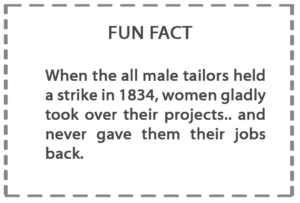

—— REAL GARMENTS FROM THE ERA ——
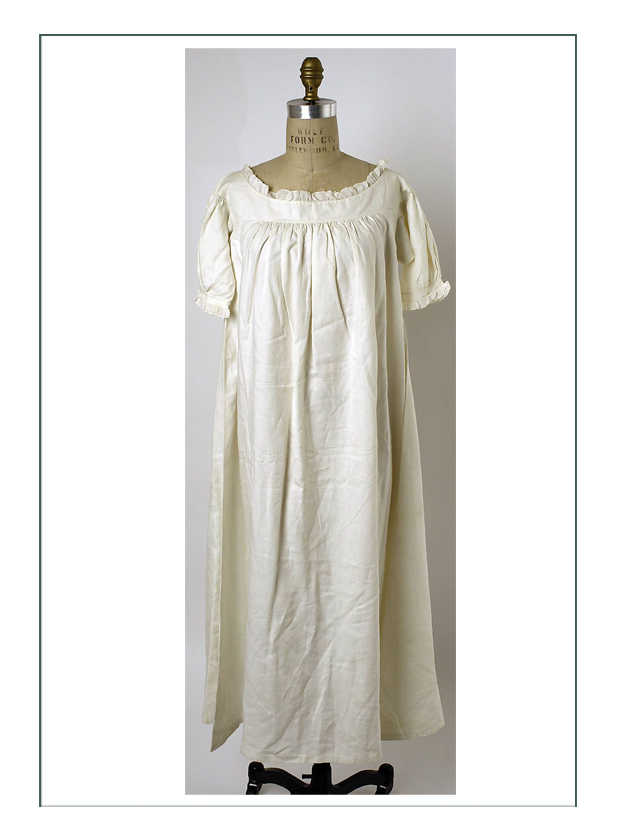
—— (above) “Night Gown 1823” ——
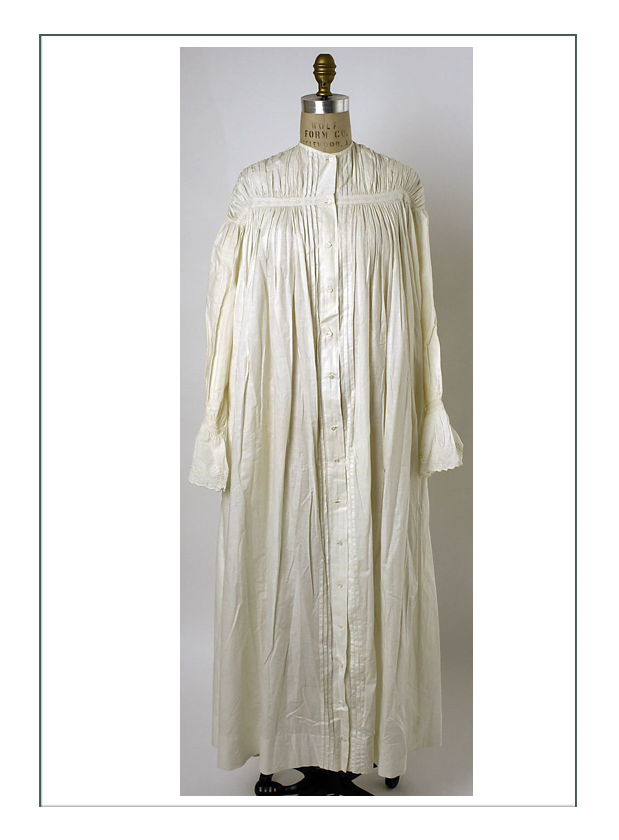
—— (above) “Night Gown 1825” ——
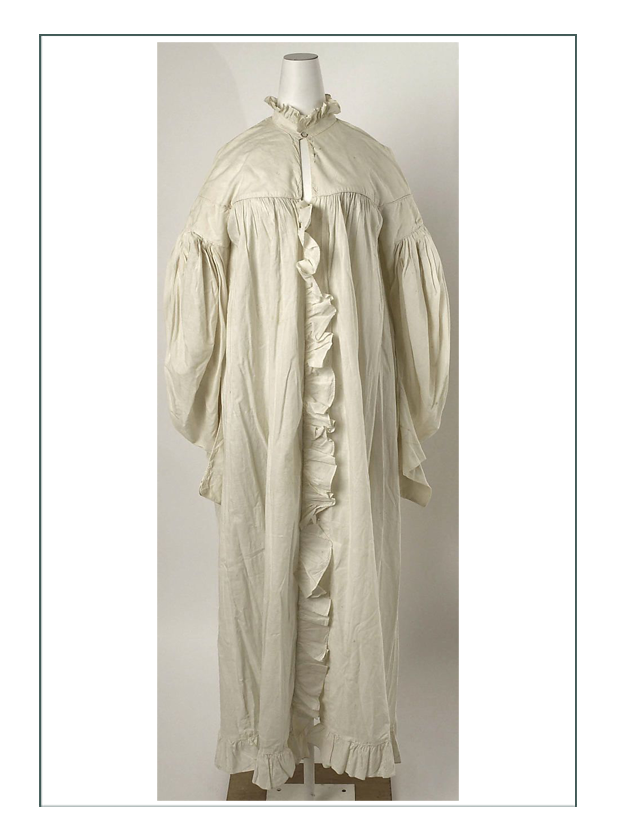 —— (above)“Dressing Gown 1836” ——
—— (above)“Dressing Gown 1836” ——
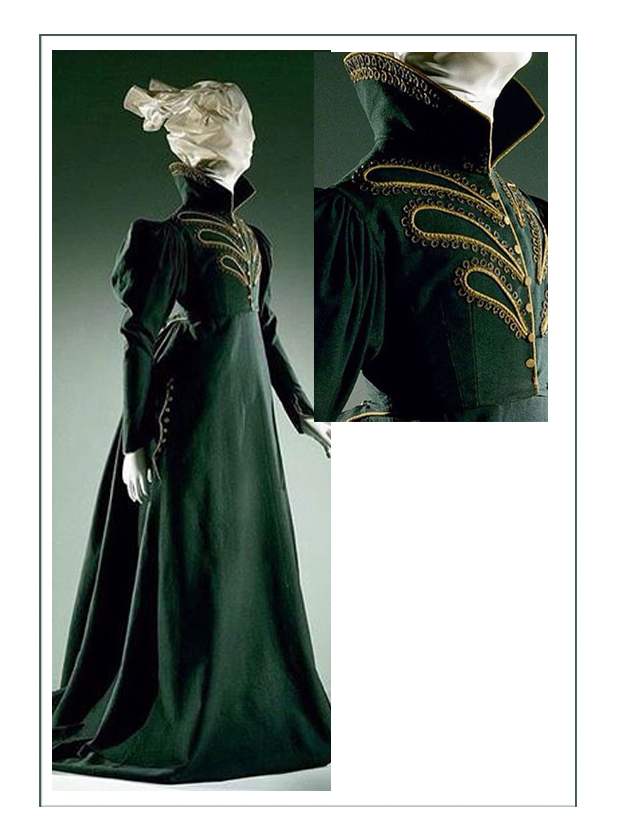
—— (above) “Riding Habit 1825” ——
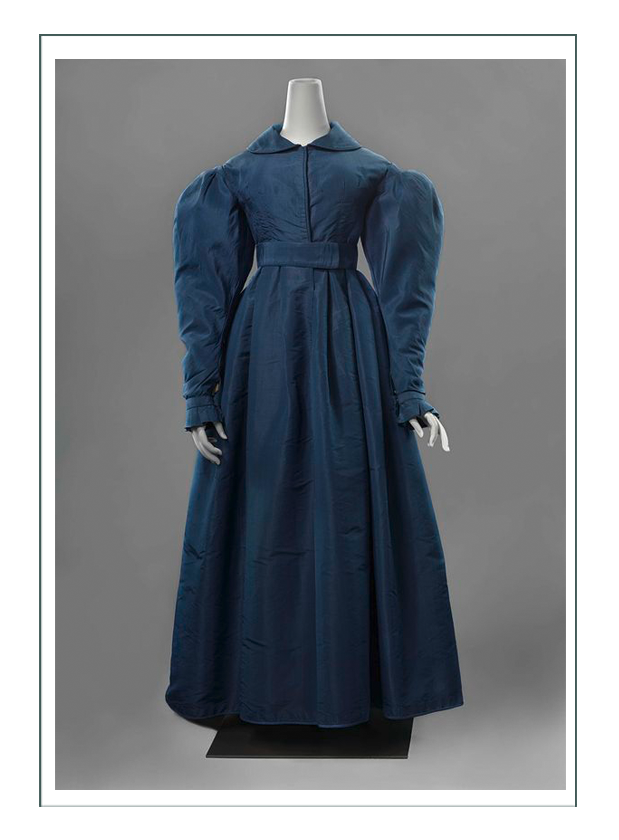
—— (above) “Redingote 1828” ——
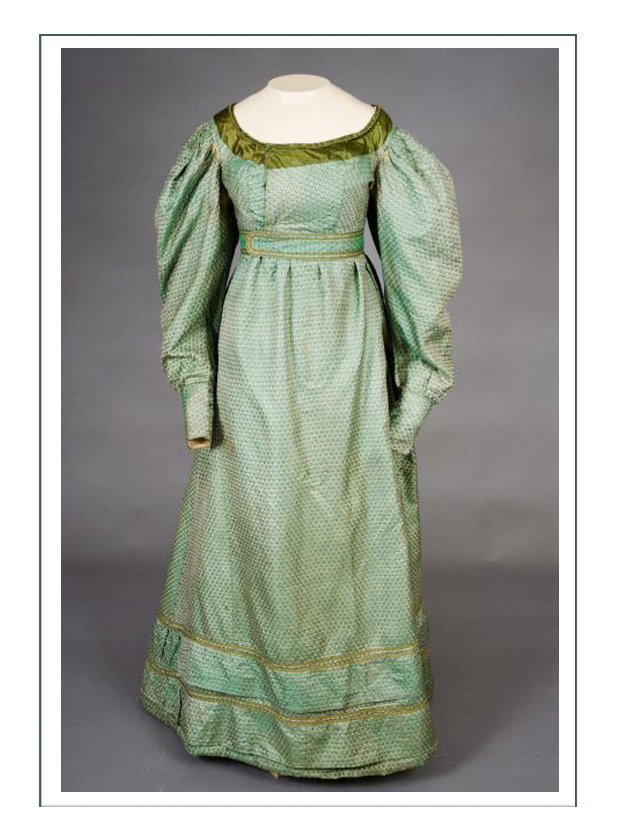
—— (above) “Casual Day Dress 1826-29” ——
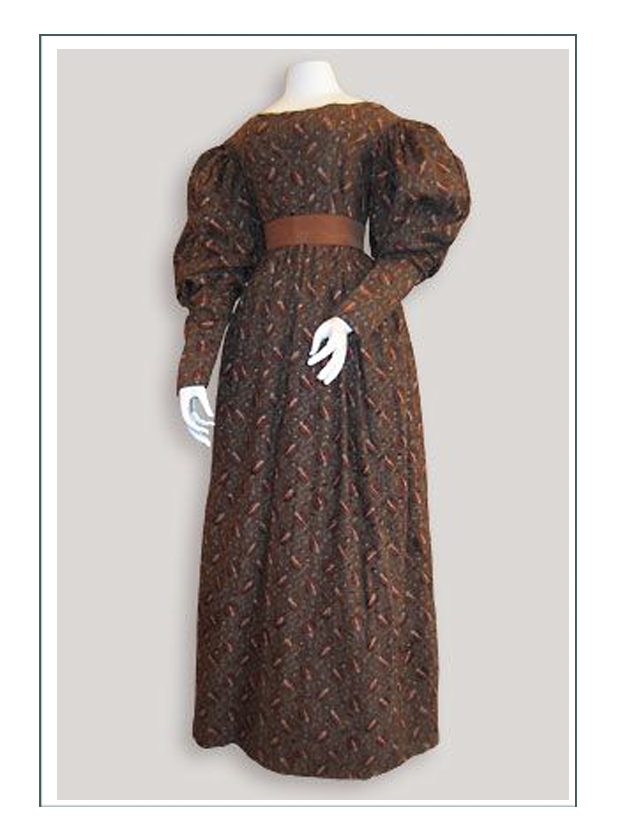
—— (above) “Every Day Cotton Gigot Sleeves 1830” ——
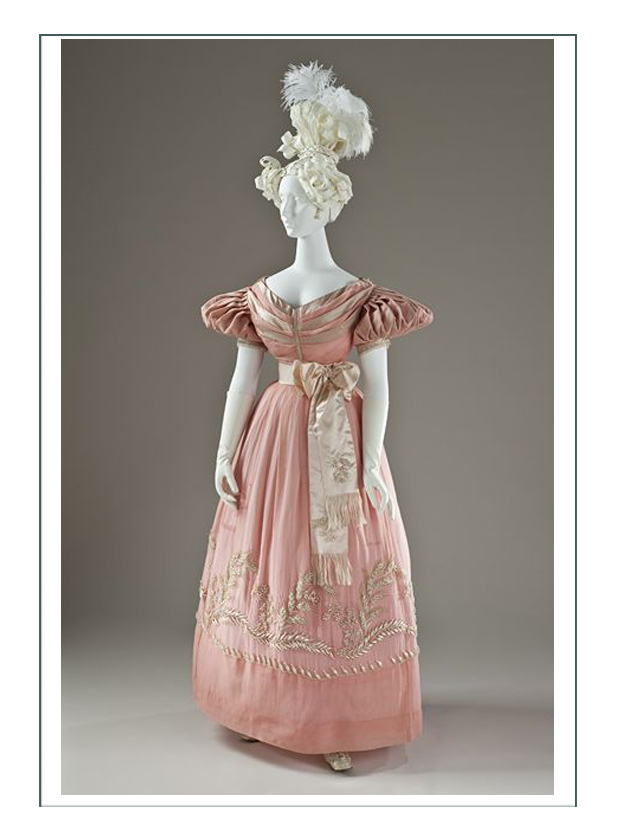
—— (above) “Formal Dress with Mancherons 1830” ——
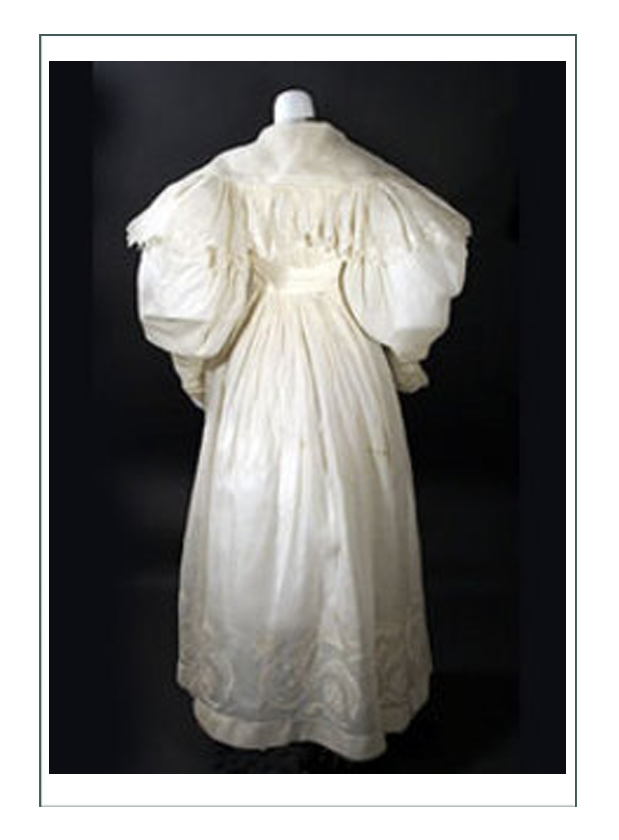
—— (above) “Morning Dress with Bertha 1830” ——
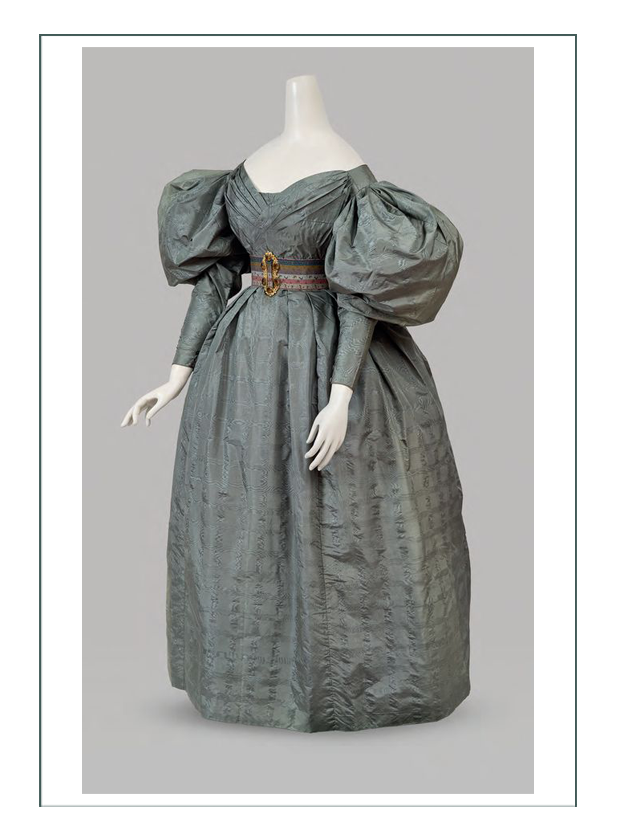
—— (above) “Evening Gown Balloon Sleeves 1832-33” ——
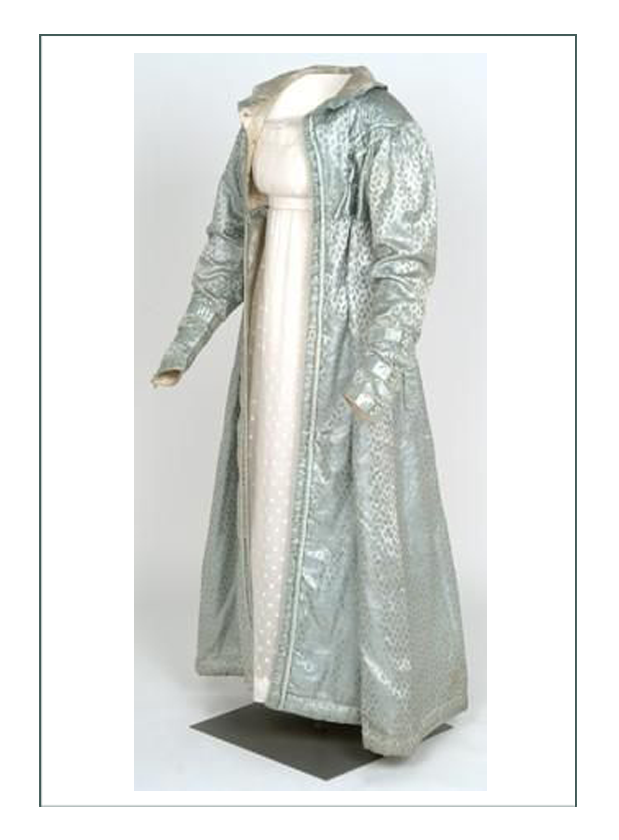
—— (above) “Pelisse 1835” ——
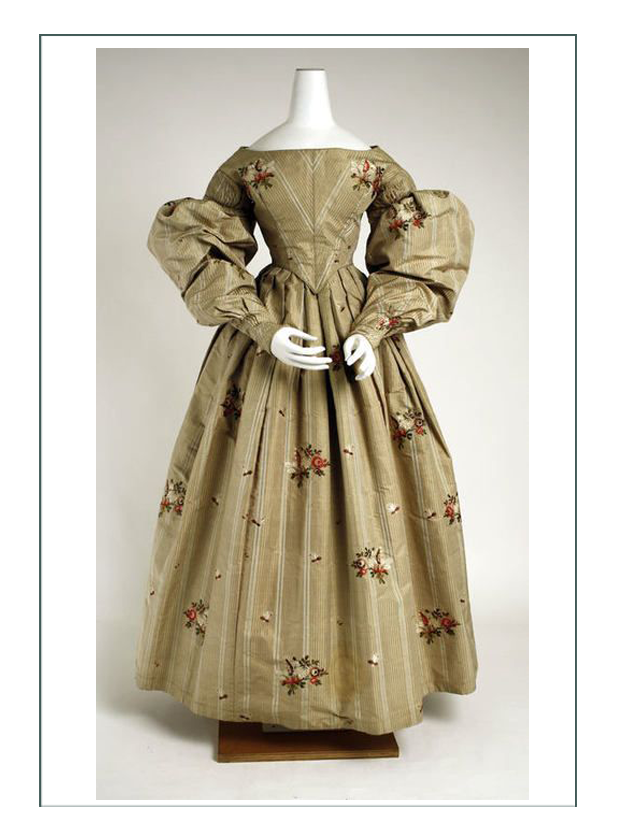
—— (above) “Silk Day Dress 1836” ——
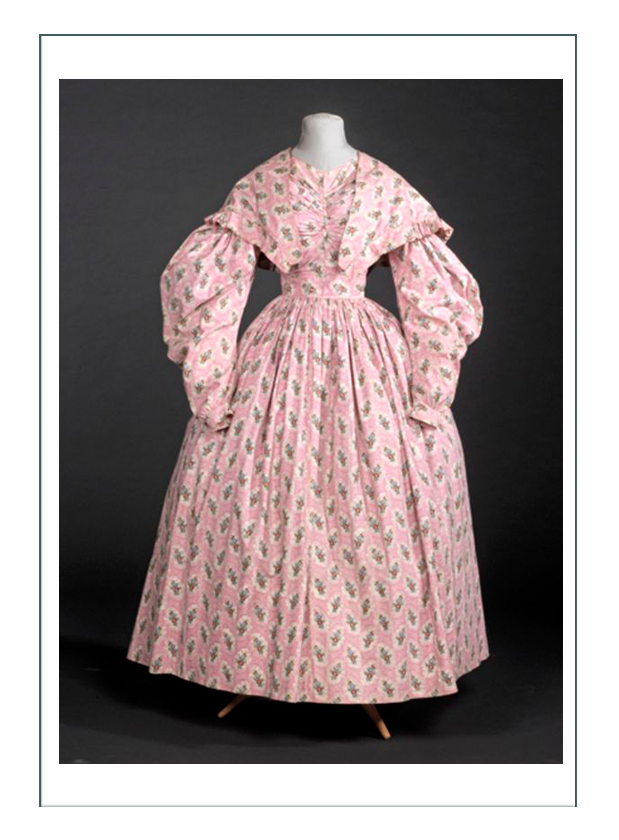
—— (above) “Modified Bertha Collar 1836” ——
Click date below to go to a different era. We can replicate most ANY garment you see!


